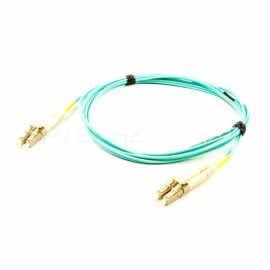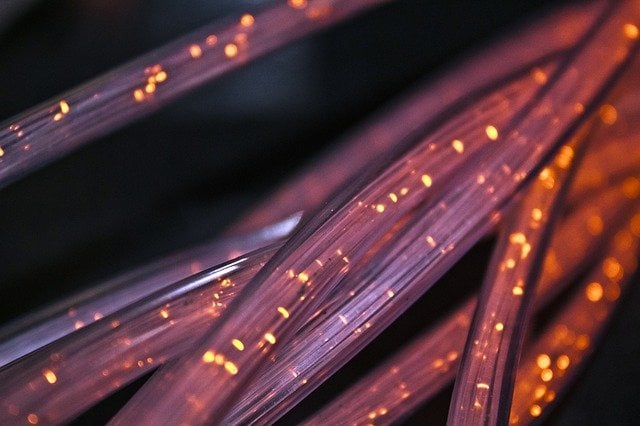Blog, Optical Networking
What Is Dark Fiber? A Complete Guide
As new technologies appear, organizations worldwide constantly need more bandwidth. Some even need dedicated data transmission networks for telecom and other services. Dark fiber is a reliable solution for these organizations, considering the immense benefits of this cable system.
The assumed size of the global dark fiber market in 2024 is $3.73 billion. It is expected to grow to $11.94 billion by 2032. The high CAGR shows the popularity of this high-speed data transmission method.
Learn more about dark fiber, its working principles, benefits, and drawbacks. We will also compare it to light fiber to help you choose a suitable mode of fiber connectivity. Let’s get started.
What Is Dark Fiber?
As you might already know, fiber optic cables are undersea cables made of thin glass fiber strands. These cables can transfer information at an astonishing speed using light.
When laying these cables out, network providers lay some extra cables to make the infrastructure future-proof. In fact, they install many more fiber optic cables than needed during installation. Not all of these cables are used for transmission.
The optic cables lying there without being used are known as dark fiber, also known as unlit fiber. As these cables don’t have any light passing through them, we can say that they aren’t ‘lit’. That means the cables are ‘dark’, which is how these cables got their name.
How Does Dark Fiber Work?
To fully understand this, you must understand how light fiber works. When using a lit fiber, organizations usually rely on ISPs for connections, troubleshooting, and everything else. ISPs manage the fiber optic cables and provide services to organizations needing fiber optic connectivity.
Dark fiber is entirely different. Suppose an organization decides to use unlit fiber for data transmission. In that case, it must buy or lease it from network providers. After purchasing or leasing the cables, the organization needs to set up its system to manage the connectivity.
The organization using dark fiber is responsible for everything, from managing the transmission bandwidth to monitoring data security. Such an organization usually needs a team of network engineers and other staff to manage such a system.
Benefits and Drawbacks of Dark Fiber
Speed-hungry and security-hungry organizations are leaning toward dark fiber, considering its benefits. However, it also has disadvantages. Before deciding to use it, check out the benefits and drawbacks.
Benefits
- Dark fiber has virtually limitless bandwidth. Unlike light fiber, businesses get the total bandwidth of dark optic fiber. This allows companies to scale their operations efficiently and quickly, as they don’t need to rely on ISPs for more bandwidth.
- When using dark optical fiber networks, organizations don’t share their networks with other organizations. Hence, the data transmitted through dark optic fiber is far more secure than that transmitted through light fiber.
- Organizations have complete control. They run the dark fiber according to their in-house policy and handle all the issues independently. So, the dependency on the ISP is much lower when using this fiber cable.
- Lower Network Latency: The owner of the dark optic fiber cable system controls the speed, making it suitable for high-speed operations like telecom, data centers, etc.
- The long-term cost of running dark fiber is considerably lower than lit fiber. Once the system is up and running, businesses can save a lot of expenses down the line.
Drawbacks
- Managing dark fiber cable systems requires in-house expertise, which can be a hassle for small businesses. However, large enterprises will face fewer challenges.
- The upfront cost may be too high for many organizations.
- It isn’t usually available in remote areas, so businesses willing to use this “unlit fiber” must operate in urban areas to enjoy its benefits.
-
Product on sale
 SC-SC 9/125 OS2 Singlemode LSZH Duplex Fiber Patch CablePrice range: US$ 2.60 through US$ 27.50 (Excl. VAT)
SC-SC 9/125 OS2 Singlemode LSZH Duplex Fiber Patch CablePrice range: US$ 2.60 through US$ 27.50 (Excl. VAT) -
 Multimode OM4 MPO to MPO Fiber Trunk Cable, 12 Fiber, Female, Type B, LSZHPrice range: US$ 21.10 through US$ 283.50 (Excl. VAT)
Multimode OM4 MPO to MPO Fiber Trunk Cable, 12 Fiber, Female, Type B, LSZHPrice range: US$ 21.10 through US$ 283.50 (Excl. VAT) -
Product on sale
 LC-LC 10G OM3 Multimode Duplex LSZH Fiber Optic Patch CablePrice range: US$ 2.80 through US$ 40.70 (Excl. VAT)
LC-LC 10G OM3 Multimode Duplex LSZH Fiber Optic Patch CablePrice range: US$ 2.80 through US$ 40.70 (Excl. VAT)
Dark vs Lit Fiber: What is the difference?
Before you settle for dark fiber, learn the differences between dark and lit fiber to make the right choice.
- Ownership and Control: Dark fiber is owned or leased by businesses. The owner controls everything about the dark network. On the other hand, lit fiber is managed by service providers, commonly known as ISPs. So, dark cable removes the intermediary.
- Cost of Operation: Dark fiber requires the owner to set up the whole system, so the initial cost of the equipment is much higher than that of lit fiber. However, the long-term operational cost of dark optic fiber is lower. Lit fiber is cheaper because the user doesn’t need to manage the infrastructure. However, the operational cost can overgrow depending on the service provider.
- Speed and Performance: The owner of dark fiber can have dedicated bandwidth for peak performance. So, dark network is more suitable for high-speed connectivity. Unfortunately, that’s not the case with lit fiber. As multiple organizations may use the same lit fiber, speed and performance are somewhat compromised.
FAQs
Q: What are the costs of setting up dark fiber?
The primary costs associated with setting up it are purchasing or leasing, equipment, and staff costs. In addition to these costs, this operation can require maintenance costs.
Q: Is dark fiber better than lit fiber?
It depends on various factors, including the size of the organization, its industry, performance requirements, in-house resources, and more. Organizations needing high-speed connectivity and more security can find dark fiber more suitable.
Q: Where is dark fiber mainly used?
It is mostly used in high-performance industries, such as telecom and healthcare. Businesses needing private networks can best use it.
Final Words
Dark fiber is a robust connectivity solution for businesses looking to scale faster. The initial investment for setting up it can be high, but it cuts down on long-term operational expenses. Besides, it greatly improves speed and security.
Understanding the critical differences between dark vs lit fiber will help you pick the most suitable connectivity mode for your business.
Read More:
- Single Mode vs Multimode Fiber, What is The Difference?
- Fiber Color Code: A Simple Guide for Beginners
- How to Clean Fiber Optic Cable Connectors
- Fiber vs Ethernet Cable: Understanding the Key Differences
- Fiber Optic Cable Distance: A Comprehensive Guide







